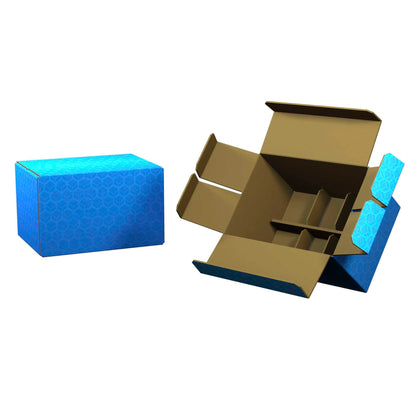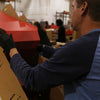

Is Corrugated The Same As Cardboard?
Although most people confuse corrugated boxes with cardboard boxes, they are not the same. This might lead to a misunderstanding of the terminology. Cardboard is a heavy-duty paper stock that is widely used to make folding cartons and other items.
Folding carton boxes covering supermarket aisles are frequently made of cardboard. Consider a cereal box or a package of mac & cheese. This is hardly the kind of package you'd expect to make it through the shipping procedure. If you send one of these in the mail, it will almost certainly arrive in tatters.
The strength of a corrugated box, on the other hand, is paramount.
A liner and a medium make up corrugated boxes. These paper sheets are bonded together. They're usually three layers of fiberboard, but they might be substantially thicker.
The linerboard, or simply the liner, is the outer layer. Liners are flat materials that are normally found on the outside of the board, but can sometimes be found on the interior, as in the case of a double or triple wall.
The flute, which is a wavy layer in the center, is the medium. Corrugated packing boxes' strength comes from this inner player, which is why they're so popular for transport and storage.
Table Of Contents
What Paper Is Used In Corrugated?
Kraft and test paper are the two most common types of paper used in corrugated boxes. The interior liner of the box is usually made of test paper, while the exterior liner is made of kraft paper.
Kraft paper is pricier than test paper, but it is of superior quality. Kraft paper is created from 70-80% virgin chemical pulp fiber and is made from softwood trees such as Pine, Spruce, and Fir. It's available in a variety of colors and textures, including brown, white, speckled, totally bleached, and birch-faced.
Kraft paper also has a smoother texture, making it easier to print on. It's also more water-resistant, which means the contents are better protected. It's also more durable than test paper due to its increased rip and burst resistance.

What Are Flutes In Corrugated?
The Flute is C-Shaped curls in between to the two substrates, also called "corrugation". It is used to strengthen or reinforce the walls of your packaging. They look like wavy c-shaped lines that are glued to a paperboard. Fluting in the box gives your packaging strength and helps withstand any damage.
The flute size influences the thickness of the box walls and the stacking strength of the box. Flutes are identified by a letter that indicates their size. They're counted by their thickness and the number of flutes per linear foot.
The most popular flute sizes are:
A Flute
At 1/4" thick, the A-Flute (33 flutes per linear foot) is the biggest flute. Because of its thickness, it provides a lot of protection and is a fantastic choice for fragile things.
B Flute
B-Flute is 1/8" thick and has 47 flutes per linear foot. This is much thinner than A-flutes, but it has a surprising amount of strength. It’s often used for counter displays or canned goods. Die-cut designs are common with this flute.
C Flute
3/16" thick C-Flute (39 flutes per linear foot). Because it's the most popular option for shipping boxes, this is definitely the one you're most familiar with.
E Flute
E-Flute (90 flutes per linear foot) is extremely thin, measuring only 1/16" thick. It lacks the strength of the larger flutes, although it does have some benefits. For folding carton boxes, it's occasionally used instead of paperboard. It's easy to store and use, and it prints well.
F Flute
F-Flute (125 flutes per linear foot) is the narrowest of the flute classes at 1/32" thick. Because of its smooth surface, printed designs will appear sharp.
What Are Walls In Corrugated?
Even if you already know what flute size you want, you'll need to make some essential choices.
Corrugated packaging is available with a variety of wall thicknesses. Sometimes you just need a little extra protection for your items, and other times you need something more substantial.
Here are the are few types of walls you can choose from:
Single-Face
This is a single sheet of liner attached to one sheet of corrugated media that is normally offered in rolls. It provides extra padding for fragile things. If you're transporting something fragile like glass or electronics, you might use this as an extra layer of protection.
Single-Wall
One sheet of corrugated medium is attached between two sheets of liner in a single-wall construction. It's the most prevalent and what most people think of when they think of a corrugated cardboard box.
Double-Wall
This is more durable than single-wall, although it is less flexible due to the additional layer. This is sometimes used in certain POP Displays and packaging when additional protection or strength is needed. But it can potentially cause issues when printing, so the artwork must be designed to work specifically with its unique structure.
Triple-Wall
With three stacked corrugated sheets and four liner board facings, this is the strongest. It's commonly utilized for industrial parts or produce containers. It's extremely heavy-duty, and can be difficult to print certain artwork, just like double-wall. So if you choose triple-wall, it must be for a certain application.
What Are Different Packaging Styles?
Finding the perfect fit is also vital when choosing the right corrugated packing box for your products. Corrugated boxes are available in a variety of forms and sizes. You don't want to squeeze your belongings, but you also don't want them to float around. There are more packaging options, but these learning about the different styles is important.
Keep in mind that the internal dimensions of a box are stated as length x width x height when choosing a box size (L x W x H).
Here are some of the most popular box styles to pick from:
Regular Slotted Container (RSC)
The most common is this one. Consider a standard shipment box. All of the flaps on this box are the same length, and when the box is closed, the two outer length flaps meet in the middle. The flaps will need to be taped together.
Full Overlap Container (FOL)
Because both sets of outside flaps fully overlap, making the box double-layered on top and bottom, this sort of box has increased strength.
One Piece Folder (OPF)
You've probably seen one of these boxes if you've ever ordered a book or other media materials online. They're folded into a box after being creased and slotted. They're sleek but functional.
Full Telescopic Design (FTD)
This box has a top and bottom that fit over each other, as the name implies. Its increased strength comes from the twin walls. Of course, these containers must be sealed in some way. For heavy-duty loads, corrugated boxes are usually sealed with packaging tape, tuck-in flaps, or strapping.
All of these options can be intimidating, but there are a variety of tools and services to help you get started on your search for the ideal box. If you'd like to learn more, you can talk to a representative at Bennett Packaging.
What Is Packaging Certification Testing?
Of course, if you've gone to the work of figuring out what flute grade and wall type you'll need, you'll want some confidence that the box will perform as expected. And, in the end, that means safeguarding the contents of the box.
Everyone wants a box that will keep their belongings safe. No one wants to find their packaging crumpled and the items inside damaged.
Corrugated boxes go through a thorough testing process when it is needed. Depending on the retailer, or situation you are in, you might need to go through one yourself.
Here are four of the main tests conducted for corrugated boxes:
Edge Crush Test (ECT)
The Edge Crush Test determines the box's stacking strength, which can help you determine things like pallet shipment durability. ECT is a laboratory test procedure that involves compressing the board's edge between two plates. It's expressed in pounds per linear inch and is used to calculate a box's maximum compression force.
Bursting Test (Mullen)
The force required to rupture or puncture corrugated cardboard is measured in the Bursting Test. This test determines how well a box will protect the contents of the box during shipping.
Flat Crush Test (FCT)
The Flat Crush Test assesses corrugated paperboard's resistance to flute crushing. Whether you pick digital or offset printing, this will help you calculate how much pressure you can safely apply to your box throughout the printing process.
Water Absorption Test (COBB)
Under defined settings, a Water Absorption Test determines how much water corrugated fiberboard absorbs over a period of time.
Order Custom Packaging Today!
Finding the right corrugated box for your needs can be a daunting task. However, with the help of this guide, you should now have a better understanding of what to look for when ordering custom packaging. Finding a packaging manufacturer is an important step in your business, and we are here to help.
Always keep in mind the importance of protecting your belongings during transit, and remember that Bennett Packaging is here to help with all of your corrugated box needs. Contact us today for a custom quote on boxes.




